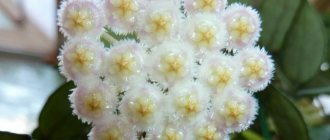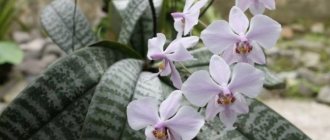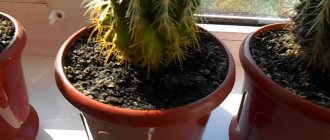We all know about such a beautiful flower as an orchid. But few people realize that the first such flowers could have existed on Earth more than 130 million years ago.
Introduced to Europe 200 years ago, orchids quickly became popular. And now, thanks to the work of botanists, you can find this plant in many homes.
Caring for a flower is extremely complex and requires taking into account many factors. But if you approach this process responsibly, then the orchid will delight you for a very long time.
Creating favorable conditions for the flower
To prevent the orchid from dying a few weeks after purchase, you need to choose the right temperature and provide the necessary lighting.
It is important to create the most favorable conditions for growth for the plant.
Watering orchids at home
Watering is a predetermining factor for the successful growth and flowering of your beauty. In nature, the vast majority of orchids are not found in water and do not tolerate prolonged stagnation of moisture. Watering orchids at home comes down to creating conditions for the plant that are close to real. To do this, you need to know what species your orchid belongs to. “Phalaenopsis”, “Paphiopedilum”, “Odontoglossum”, “Cymbidium” always prefer a slightly moist, but not wet substrate, but the soil for “Oncidium”, “Dendrobium”, “Cattleya” must be dry before watering.
In addition, the intensity of watering is also influenced by such factors as temperature and humidity, lighting intensity, pot size, substrate composition, and the phase of the seasonal growing season. Orchids are epiphytic plants, so they can tolerate dry soil for a short time. But if you do not water systematically, the orchid’s leaves will begin to wither and wrinkle, and if there is excess watering, there is a high probability of rotting of the root system and the formation of yellowness around the perimeter of the leaf.
It is advisable to water the orchid with soft water. The ideal option would be to pre-settle rainwater in the summer and melt water in the winter. You can also boil tap water. The water temperature for irrigation should be 2 - 3 degrees warmer than the surrounding air. In summer, the orchid is watered 2-3 times a week, when the outer layer of the substrate dries out. In winter, watering is reduced to a minimum of 1 - 2 times a week; a slight wrinkling of the pseudobulb will serve as a signal for watering.
An orchid planted in a pot is watered from above, and in blocks or baskets it is immersed in water for 3 to 5 minutes. In both cases, it is necessary to allow excess water to drain, and in no case allow it to stagnate.
Choosing lighting for a plant
The orchid is a light-loving flower, but it does not require direct sunlight, but soft, diffused lighting. The lack of necessary lighting will lead to a change in the color of the leaves - they will gradually lighten, stretch out, and soon turn yellow.
At the same time, in summer you need to cover the plant from direct sunlight. After all, intense lighting can cause burns. And in the spring, you should gradually adapt the flower to solar radiation using a matte film on the windows or plastic.
In autumn, the darkening can be removed, because solar radiation is no longer too active. And soft sunlight will contribute to better ripening of shoots, better formation of shoots and the transition of the flower to a dormant state.
The climate zone greatly influences the conditions that the plant needs to create. If daylight hours in your area do not exceed 10 hours, then additional artificial lighting using fluorescent lamps is required.
What to do with an orchid immediately after purchase?
First of all, as soon as the orchid gets into your house, place it in quarantine - in isolation from other flowers. This is necessary to prevent the possible spread of pests and diseases from the new plant. The duration of quarantine is 2-3 weeks.
During this time, the exotic will also adapt to new conditions of care and maintenance. To ensure everything goes smoothly, do the following:
- find a bright place for the orchid, without direct sunlight and away from heating devices;
- spray the leaves with Epin - it will help you easily survive the stress of changing conditions and transportation;
- do not rush to water immediately, the first watering is usually 7-10 days after purchase;
- Periodically inspect the plant for insects; they usually hide under the leaves. If living illegal immigrants are found, they will need to be treated with Aktara, Fitoverm or another suitable drug.
After quarantine is completed, if the orchid is healthy, you can send it to a permanent place of residence next to other indoor plants.
Creating a comfortable temperature regime
To choose the right temperature, it is necessary to take into account the differences in requirements for individual groups of orchids:
Heat-loving flowers (phalaenopsis, dendrobiums) need warm temperatures all year round. Summer mode 15-32 degrees and winter mode 15-18 degrees Celsius are suitable for them. In this case, the temperature difference during the day should not exceed 3-5 degrees.
Medium-temperature orchids (odontoglossums, miltonias) prefer cooler conditions. In summer the temperature should be 18-22 degrees, and in winter – 12-15 degrees.
Cold-resistant plants (Australian dendrobiums, paphiopedilums, laelias) grow at a summer daytime temperature of 22 degrees and with a winter night temperature of 12 to 15 degrees.
From the history of orchids
The first orchids, according to scientists, were recorded on Earth 130 million years ago. Although they really became widespread about 3-4 thousand years ago, in China and Japan. Orchid at that time was considered a medicinal plant, as Confucius mentioned in his writings.
Orchids appeared in Europe relatively recently, about 200 years ago. During this time, the number of orchids reached 30 thousand species.
The history of orchids is full of myths and legends. As one old legend says, an orchid appeared from the fragments of a broken rainbow. Another legend says that a beautiful orchid grew in the place where Aphrodite lost her slipper. The orchid is a symbol of love and rebirth.
Thanks to botanical scientists, it has become possible to grow this exotic flower at home. Let’s immediately say that caring for an orchid at home without special knowledge will cause you a lot of trouble, and most likely you will lose your specimen. But, if you familiarize yourself with the features of care, your beauty will delight you with her appearance for a long time. Well, let's begin.
Orchid replanting and pruning
If the old pot has become small or damaged, living roots are intertwined with dead ones, the substrate has become salty or formations have appeared on its surface, then it is necessary to replant the plant.
To do this, you need to carefully remove the orchid from the pot. To avoid damaging the root, it is advisable to cut the container. The roots are cleaned, old and damaged elements are removed with scissors. The root system must be washed with clean water. Then a new composition is poured into the bottom of the new pot.
When the plant is placed in a container, new soil should be poured into the spaces between the roots. The top should not be covered. Then the soil is moistened and placed in the shade for several days.
Pruning of the peduncle should be done at the base or where there were previously flowers. The presence of dormant buds allows you to count on the appearance of lateral peduncles or children.
Remember, if cracks appear in the center of the leaves, this is evidence of sudden temperature changes or damage. Flabby leaves indicate problems with the root system or incorrect temperature, and growths and black spots are sunburn.
When the leaves rot and a silvery cobweb appears on the back side, the problem may be pests. Therefore, it is necessary to use acaricides.
Following the conditions for caring for orchids will allow you to create a blooming garden at home. These plants will delight you with their bright flowers for a long time.
The orchid has faded: what to do with the arrow, how to care for it?
After flowering, you need to decide what to do with the peduncle. There are three options:
- Remove completely , cut as close to the bottom as possible. Especially if it starts to dry out.
- Shorten to a living bud . To do this, cut off the arrow above the first bud under the withered flower. There is a possibility that a branch begins to grow from it, and the orchid blooms again.
- Leave untouched . In this case, after 2-3 months it may begin to grow in length again, and flowers will appear on it.
After flowering, it’s time to replant the phalaenopsis and change its care: reduce watering, as well as the amount of fertilizer applied. This will give the plant a little rest.
Do I need to remove the spent stem?
Not necessary. If the peduncle does not yet turn yellow, this means that it has not dried out and can bloom again. True, there will be few flowers, and they will be smaller. If it begins to turn yellow and dry out, prune it.
Photos of orchid care
leave a comment
Click to cancel reply.
You must log in to post a comment.
Orchid bloom at home
You were given an orchid as a gift and it quickly faded? Almost everyone does. Making an orchid bloom is not an easy task for a novice gardener, as we already know that an orchid is a demanding plant.
Let's take a closer look at what factors determine the frequency of orchid flowering and how to get an orchid to bloom at home.
When purchasing an orchid in a flower shop, ask about its age; usually orchids begin to bloom at the age of 1.5 to 2.5 years.
- The first most influential factor on the flowering of orchids is the length of daylight hours. For each specimen, there is a certain length of daylight hours, which allows for the full formation of peduncles. Compliance with this factor serves as a signal for the formation of flower buds in the orchid. A lot of time may pass between the process of bud formation and the formation of a peduncle; you should be patient.
- The second factor is observing the difference between night and day temperatures. The difference should be in the range from 5 to 7 degrees.
If after this the orchid does not bloom? There are several more ways to make an orchid bloom at home.
- Temperature drop to +16 degrees for two weeks.
- Reducing watering (changing the usual regime).
When you achieve flowering, the orchid will delight you with its beautiful flowers for 2 to 8 months, depending on the type and number of flower buds. During orchid flowering, watering is doubled. After the orchid has finished blooming, collect the dry buds and begin the feeding cycle.
Flower health assessment
First of all, so that caring for an indoor beauty does not turn into daily resuscitation of the plant and does not seem like hard labor, the health level of the flower is assessed. This can be done based on three main parameters.
- Leaves. They should be elastic, fleshy, and look alive. At the same time, the characteristics inherent in a particular type of orchid are observed. For example, venation. Under no circumstances should any stains, dots or other inclusions be present. Also, the leaves should be periodically wiped from dust. This can be done either with simple filtered water or with succinic acid.
- Roots. First of all, they are judged by color. The roots of an unwatered plant are silvery, while those of a watered plant are green.
- Under no circumstances should rotting or even a hint of such a process be allowed. There should be no dry or rotten roots. If the root changes color to yellow or brown, it means it has rotted. Healthy orchid roots are silver-green or white depending on the type of orchid.
- Container-pot. Clean, without mold or signs of moss - an ideal pot. When choosing a pot, you need to be guided by the type of orchid; terrestrial ones are usually grown in opaque pots, and others in transparent ones, since the roots of such orchids also participate in photosynthesis and they need light.
Important! You should pay attention to the growing point of the flower. She must be intact.
Orchid flower - description
Orchid... The flower is delicate, incredibly beautiful and whimsical. But all the work spent on the orchid will be rewarded with interest in the form of incredible flowers. They rise on a thin and long stem like bright butterflies hovering in the air. You can fall in love with this flower once and for all and the love will be mutual.
There are secrets to the proper growth and flowering of orchids. Now they will be revealed.
So let's get started!
Propagation of orchids at home
If you are growing orchids and have already become imbued with all its features, you can safely propagate your favorite specimen. Propagating orchids at home is a task for an experienced gardener. Orchids are propagated by: dividing large plants, lateral shoots, apical cuttings, pseudobulbs, pups, and seeds. You can read more about this here.
Types of photosynthesis in orchids
Currently, several types of photosynthesis have been identified in orchids:
- C3 photosynthesis;
- C4 photosynthesis;
- CAM (Crassulacea Acid Metabolism);
- C3-SAM (self-switching photosynthesis).
C3 photosynthesis
During C3 photosynthesis, carbon dioxide enters the plant through open stomata, both during the day and at night.
The peculiarity of C3 photosynthesis is that the absorption of carbon dioxide occurs in one place of the leaf, and its processing in another.
C4 photosynthesis
During C4 photosynthesis, the stomata are partially covered during the day. Such photosynthesis is an adaptation of plants to survive drought, high temperatures, salinity of the substrate and lack of carbon dioxide.
CAM photosynthesis
During CAM photosynthesis , plants close all stomata during the day to avoid excessive water loss, and the absorption and transformation of carbon dioxide occurs only at night.
The same type of carbon storage is used by desert plants - cacti and succulents.
Self-switching C3—CAM photosynthesis
Self-switching C3-CAM photosynthesis is quite widespread among epiphytic and lithophytic orchids from regions with a clear alternation of dry and wet seasons.
Under favorable climatic conditions (optimal temperature, sufficient light), the stomata of these orchids are open during the day, carbon dioxide enters the plant during the day, and they function like ordinary plants with C3 photosynthesis.
As soon as the conditions change dramatically (lack of water, lack of light, a strong decrease in night temperatures, excess salts in irrigation water, etc.), the orchid switches to night-time consumption of carbon dioxide according to the CAM type.
CAM orchids close their stomata during the day to minimize water loss. They breathe and absorb carbon dioxide and water only in the dark, at low temperatures and high humidity.
Almost all orchids with thick, fleshy leaves are prone to self-switching C3 - CAM photosynthesis , this is especially true for monopodially growing orchids, including Phalaenopsis.
In conditions of high air humidity and good light, plants consume carbon dioxide, resorting to C3 photosynthesis, leaving stomata open during the day, quickly increase biomass and bloom easily .
As soon as the conditions for keeping orchids deteriorate, it becomes a plant ITSELF, whose leaves thin out, become smaller and grow more slowly .
Light compensation point
When the intensity of photosynthesis (the amount of carbon dioxide consumed) and respiration (the amount of carbon dioxide released) are equalized, the so-called light compensation point .
In shade-tolerant orchids, the light compensation point is 1% of total illumination (250-300 lux), in light-loving orchids - 3-5% (800-2000 lux).
The formation of new cells begins after increasing this light level. With a lack of light, the plant becomes depleted.
Three states of the orchid can be distinguished :
- Being at the compensation point - nothing happens.
- Being in a state ABOVE the compensation point - the orchid begins to grow roots, leaves, etc.
- Being in a state BELOW the compensation point - the leaves and roots dry out, and as a result the plant dies.
In addition to illumination, the light compensation point is strongly dependent on temperature.
The higher the temperature , the more actively plants respire, which causes additional energy costs and upsets the balance between the production and consumption of carbohydrates during photosynthesis and respiration.
The orchid begins to give back more than it produces, and compensates for the lack of carbon by taking it from old leaves, shoots and roots.
Previously accumulated nutrients are spent only on maintaining one’s own vital functions, and there is no energy left for development.
IMPORTANT! High temperatures at night are harmful to orchids, as is low light during the day, since they prevent the fixation of carbon dioxide.
An orchid growing at constantly elevated temperatures and low light levels stops forming flower stalks, thus trying to save some of the energy spent on breathing.
If the situation has not changed, the temperature remains high and respiration still prevails over photosynthesis, shoots and leaves begin to shrink .
As a result, small pseudobulbs and leaves will not be able to accumulate sufficient nutrients for next year's growth.
smaller and smaller every year .
Such negative development dynamics can result in the death of the plant.
The maximum productivity of photosynthetic reactions in plant cells of C3 orchids is observed in the temperature range of 20–35 °C.
At higher temperatures , the intensity of photosynthesis decreases, and at temperatures above 42 ° C, irreversible processes occur in the orchid’s body, leading to burns or even death.
At daytime temperatures of 13 °C and below, the intensity of photosynthesis also decreases.
A decrease in night temperatures is one of the main conditions for the growth of green biomass and the formation of flower stalks.
If the room is hot at night ( above 24 °C ), the process of formation of new tissues slows down, and the plant again takes carbon from its old organs - leaves, stems, peduncles and roots.
When it becomes too hot ( above 32 °C ) and dry (humidity drops below 70%), carbon dioxide from the air stops flowing into the leaves through the stomata.
Instead, the reverse process occurs through them - the release of moisture, which protects the plant from overheating.
Having given up all possible water, the stomata close for a long time, and the plant's photosynthesis switches from C3 to CAM to prevent leaf wilting from excessive evaporation.
With prolonged CAM mode, irreversible processes can begin in orchid leaves, during which their cells begin to gradually die.
In winter, special attention should be paid to caring for orchids when kept at home.
Low light on the windowsill requires lowering the temperature.
At low temperatures , the intensity of photosynthesis decreases, and a short day reduces the period of already ineffective photosynthetic activity of the plant.
How to find out the requirements of an orchid for light?
How to find out whether an orchid requires light, especially if its name or origin is unknown? The plant itself can help here.
Species with hard, leathery, thickened leaves require a lot of light, and if the leaf has a cylindrical cross-section, then perhaps the maximum amount.
A typical example is the genus Vanda. Vandas are very sun-loving, but one of them, Vanda teres, which has cylindrical leaves, is so demanding of light that at the latitude of Moscow it does not bloom every year, but only after a very hot and sunny summer.
Oncidium splendidum, an orchid from Mexico with hard sword-shaped leaves and a small flat bulb, also grows in open areas in direct sun.
Cattleyas and dendrobiums need a little less light
Orchids with bulbs and thin leaves need even less light . These include (as the need for light decreases): catasetums, lycastes, coelogines, calanthus.
Plants with leathery, soft and wide leaves without bulbs and soft-leaved alpine species with bulbs require even less light , these are phalaenopsis, miltonia, odontoglossum.
Orchids with soft, delicate leaves and thin stems - anectochilus, makodes - have the least needs
Appearances can sometimes be deceiving . If you expose catasetum and calanthus, which are similar in appearance, to direct sun, then the former will only benefit from this, and the leaves of the calanthus will quickly burn.
The rosettes of Paphiopedilums, which in appearance are usually placed in the shade, actually require slightly less light than Cattleyas.
The color and structure of orchids is a good indicator of the correctness of the chosen lighting conditions.
Like indicator paper, the color of their leaves changes depending on light conditions.
In a healthy orchid they are bright green. If the leaves darken , the plant clearly does not have enough light; if they turn yellow or take on a reddish tint, there is too much light.
Gentle but meticulous transplantation
Orchids need to be replanted on average every 2 years. These plants must be handled with extreme care, because the roots are easily injured and broken off. The substrate is replaced completely. Orchids require special soil mixtures for these types of plants, consisting of coarse parts of bark, moss and other useful components. Before planting, you need to carefully examine the plant and remove all soft, damaged, dry areas by treating the cuts with charcoal. Orchids are not buried; they are carefully placed on a mound at the bottom of the pot, and then the free space is filled with substrate. If you are afraid of damaging the orchid rhizome during transplantation, for the first procedure, ask a fellow florist who already knows how to handle orchids to assist you. After the procedure, do not water the plant for at least 3 days, and resume feeding only after a month.











